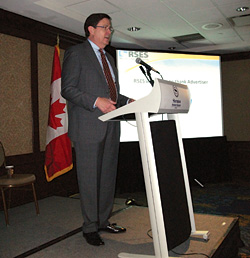
|
| Robert Wilkins (pictured here speaking at last fall’s RSES International Conference) has long been monitoring ongoing developments in refrigerant-related regulations from a global perspective. |
Recent action on the global and domestic stages — like the Obama administration’s Climate Action Plan unveiled earlier this year — has reignited conversation about climate change and is sparking a renewed sense of urgency about refrigerant policy. But even though what’s on the table and what’s on the horizon may, for the time being, be incongruous, an actionable plan for the global phase down of hydrofluorocarbon (HFC) refrigerants is gaining more momentum today. This is particularly relevant with hydrochlorofluorocarbon (HCFC) refrigerant production sharply limited and the emergence of new, low-GWP [global warming potential] natural refrigerants throughout the global market.
Today, there is a growing concern that the rapidly multiplying air conditioning and refrigeration installations in developing countries are causing rapid growth in the volume of HFCs being used. With GWPs 2,000-4,000 times the GWP of carbon dioxide (CO2), the prospect of rampant HFC usage is expected to reverse the dramatic progress the Montreal Protocol made in reducing ozone depleting substances, many of which also had very high GWPs. This underscores the need for a global solution, and is a concern that has been voiced by the proposed North American amendment to the Montreal Protocol. The proposal most recently was resubmitted at the 25th Meeting of the Parties on Oct. 25, 2013, in Bangkok.
Many advocates and policy makers are taking action now to find and use refrigerants with much lower GWPs than HFCs to anticipate the phase down and avoid what could be a costly double transition. In the meantime, the North American amendment proposal supports “a gradual phase down in the consumption and production of HFCs.” A declaration of support for the amendment was endorsed by nearly 110 countries, proving the level of concern among most of the world’s countries about the GWP of HFCs. China and India have supplied the strongest opposition.
But, recently, the prospects of the amendment proposal were strengthened following an agreement between President Obama and President Xi of China in July. Then, on Sept. 6, at their Summit in St. Petersburg, the leaders of the G20 countries, including India, supported the decision to use “the expertise and the institutions of the Montreal Protocol to phase down the production and consumption of hydrofluorocarbons.” Six additional countries later gave their support as well.
However, at the annual Meeting of the Parties in October, India and Saudi Arabia would not even permit discussing details of a phase down. Much of the movement depends on India, which, with China now lending its support to the amendment, has the strongest opposing voice. While Indian manufacturers are beginning to convert to alternative refrigerants, the Indian government remains strongly opposed. Its concerns likely include the projected growth of air conditioning and refrigeration in the country and the costs of switching to alternatives. Politics also could be a factor as India’s next presidential election will take place in the spring. Nevertheless, diplomats today are urging India to support the formation of an international contact group to identify issues and seek solutions.
U.S. HFC Refrigerant Policy
While world institutions make slow progress toward a global agreement, the pressing question is — how is the U.S. planning to handle HFCs in the meantime?
The president’s Climate Action Plan, issued in June 2013, directed the U.S. Environmental Protection Agency (EPA) to exercise its authority through the Significant New Alternatives Policy (SNAP) program to encourage investment in “low-emissions technology by identifying and approving climate-friendly chemicals while prohibiting certain uses of the most harmful chemical alternatives.”
SNAP is generally considered to be EPA’s legislatively mandated process to evaluate and approve alternatives to ozone-depleting substances. So, the president’s call for using SNAP as a vehicle to phase down HFCs demonstrates that the administration is serious about taking steps to reduce HFCs. Many in the HVACR industry believe that this approach reaches beyond SNAP’s intended purpose, and likely would be cumbersome and ineffective.
Accordingly, SNAP is expected to delist several high-GWP refrigerants — namely HFC-404A (with a GWP of 3,784) and HFC-507 (with a GWP of 3,850) — for use in new low-temperature commercial refrigeration systems.
Meanwhile, several U.S. HVACR OEMs and end users — recognizing the growing issue and concluding that it is not a question of whether a phase down will occur, but simply a matter of when — have already begun implementing HFC alternatives. In fact, it has been estimated that more than 100 supermarkets in the U.S. have either completed installation or ordered carbon dioxide refrigeration systems. SNAP-approved CO2 for food retail refrigeration in 2009 and approved propane and isobutane — subject to charge limitations — in 2011. As a result, many also have invested in working to change building safety standards to permit the use of these hydrocarbons.
The automotive industry also has set out to explore new low-GWP alternatives. In fact, in May 2012, General Motors (GM) rolled out the Cadillac XTS in North America using hydrofluoroolefin (HFO)-1234yf, and today, more than 100,000 GM vehicles using HFO-1234yf are on the road globally. In Europe, an even larger combined number of vehicles from OEMs, such as Hyundai, Subaru, Ford, and BMW, are using such alternatives.
Of course, compared to the HFC-installed base, the scale of alternatives in use is small. But, it’s growing. Worldwide, hundreds of supermarkets are using CO2 and more than 100 million residential refrigerators use hydrocarbons. Technological hurdles are being overcome, and the low-GWP refrigerant transition is underway and gaining momentum.
Proactive HFC Response by the HVACR industry
Further movement in the refrigerant transition in the U.S., however, will involve becoming more educated about alternative technologies. As the industry grows more familiar with the technology, and the number of installations increase, manufacturers will scale up the production of non-HFC equipment, making it critical that contractors be ready and able to install and service this new equipment. Today, contractors should seek training that will prepare them for the changes and improve skills in refrigerant recovery and reuse, and to prevent venting of HFCs when they are being phased down. It’s also important that contractors revisit their policies regarding refrigerants, and work proactively with customers to solve leak issues, reduce emissions, and establish refrigerant
management plans.
In the next few years, it is clear that both policy-driven and market-driven factors will play a role in spurring the transition from HFCs. Although the SNAP program may play a role, a planned, orderly HFC phase down process would better serve the HVACR industry. However, this would require authorization of Congress, which is not likely to occur anytime soon.
Looking ahead, more and more commercial refrigeration OEMs and end users, such as supermarkets, can be expected to switch to natural refrigerants because of the business advantages. At the same time, many OEMs and end users are exploring alternatives because it is the right thing to do in response to climate-change concerns. Already, early adopters are discovering that advanced energy management systems, reheat options for hot water production and space heating, and variable-speed technologies can save energy in off-design conditions, while reducing the facility’s environmental footprint. Given the progress made under the Montreal Protocol — and now with the focus shifting to an HFC phase down — the HVACR industry will benefit by responding proactively to ongoing climate change concerns by anticipating the continued momentum of alternative refrigerants and future actions and policy both in the U.S. and abroad.
Publication date: 3/3/2014
Want more HVAC industry news and information? Join The NEWS on Facebook, Twitter, and LinkedIn today!







